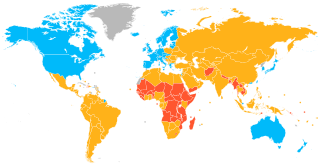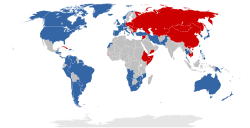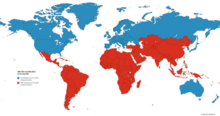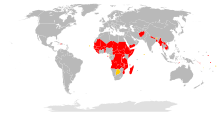
A developing country is a sovereign state with a less developed industrial base and a lower Human Development Index (HDI) relative to other countries. However, this definition is not universally agreed upon. There is also no clear agreement on which countries fit this category. The terms low and middle-income country (LMIC) and newly emerging economy (NEE) are often used interchangeably but refers only to the economy of the countries. The World Bank classifies the world's economies into four groups, based on gross national income per capita: high, upper-middle, lower-middle, and low income countries. Least developed countries, landlocked developing countries and small island developing states are all sub-groupings of developing countries. Countries on the other end of the spectrum are usually referred to as high-income countries or developed countries.

International relations (IR) are the interactions among sovereign states. The scientific study of those interactions is also referred to as international studies, international politics, or international affairs. In a broader sense, the study of IR, in addition to multilateral relations, concerns all activities among states—such as war, diplomacy, trade, and foreign policy—as well as relations with and among other international actors, such as intergovernmental organizations (IGOs), international nongovernmental organizations (INGOs), international legal bodies, and multinational corporations (MNCs). There are several schools of thought within IR, of which the most prominent are realism, liberalism and constructivism.

A failed state is a state that has lost its ability to fulfill fundamental security and development functions, lacking effective control over its territory and borders. Common characteristics of a failed state include a government incapable of tax collection, law enforcement, security assurance, territorial control, political or civil office staffing, and infrastructure maintenance. When this happens, widespread corruption and criminality, the intervention of state and non-state actors, the appearance of refugees and the involuntary movement of populations, sharp economic decline, and military intervention from both within and outside the state are much more likely to occur.

The concept of the First World was originally one of the "Three Worlds" formed by the global political landscape of the Cold War, as it grouped together those countries that were aligned with the Western Bloc of the United States. This grouping was directly opposed to the Second World, which similarly grouped together those countries that were aligned with the Eastern Bloc of the Soviet Union. However, as the Cold War ended with the dissolution of the Soviet Union in 1991, the definition largely shifted to instead refer to any country that boasts a well-functioning democratic system with little prospects of political risk, in addition to a strong rule of law, a capitalist economy with economic stability, and a high standard of living. Various ways in which these metrics are assessed are through the examination of a country's GDP, GNP, literacy rate, life expectancy, and Human Development Index. In colloquial usage, "First World" typically refers to "the highly developed industrialized nations often considered the Westernized countries of the world".

The Second World is one of the "Three Worlds" formed by the global political landscape of the Cold War, as it grouped together those countries that were aligned with the Eastern Bloc of the Soviet Union. This grouping was directly opposed to the First World, which similarly grouped together those countries that were aligned with the Western Bloc of the United States. It included communist states that were originally under the Soviet sphere of influence, though some eventually broke away from the Soviet ideology to develop their own path as socialist states while retaining their communist governments. Most communist states remained under Soviet influence until the Revolutions of 1989. In 1991, upon the dissolution of the Soviet Union, only five communist states remained: China, Cuba, Laos, North Korea, and Vietnam. Though the terms "First World" and "Third World" continue to see present-day relevance in colloquial speech, albeit with a repurposed definition, the term "Second World" is obsolete outside of a Cold War context.
Neocolonialism is the continuation or reimposition of imperialist rule by a state over another nominally independent state. This is the continuation of colonial representations and realities which remain after formal colonisation has come to an end. Neocolonialism is the control of less-developed countries by developed countries through indirect means. The term neocolonialism was first used after World War II to refer to the continuing dependence of former colonies on foreign countries, but its meaning soon broadened to apply, more generally, to places where the power of developed countries was used to produce a colonial-like exploitation.Neocolonialism takes the form of economic imperialism, globalization, cultural imperialism and conditional aid to influence or control a developing country instead of the previous colonial methods of direct military control or indirect political control (hegemony).

Global North and Global South are terms that denote a method of grouping countries based on their defining characteristics with regard to socioeconomics and politics. According to the United Nations Conference on Trade and Development (UNCTAD), the Global South broadly comprises Africa, Latin America and the Caribbean, Asia, and Oceania. Most of the Global South's countries are commonly identified as lacking in their standard of living, which includes having lower incomes, high levels of poverty, high population growth rates, inadequate housing, limited educational opportunities, and deficient health systems, among other issues. Additionally, these countries' cities are characterized by their poor infrastructure. Opposite to the Global South is the Global North, which the UNCTAD describes as broadly comprising Northern America and Europe, Israel, Japan, South Korea, Australia, and New Zealand. As such, the two terms do not refer to the Northern Hemisphere or the Southern Hemisphere, as many of the Global South's countries are geographically located in the former and, similarly, a number of the Global North's countries are geographically located in the latter.

International development or global development is a broad concept denoting the idea that societies and countries have differing levels of economic or human development on an international scale. It is the basis for international classifications such as developed country, developing country and least developed country, and for a field of practice and research that in various ways engages with international development processes. There are, however, many schools of thought and conventions regarding which are the exact features constituting the "development" of a country.
Dependency theory is the idea that resources flow from a "periphery" of poor and exploited states to a "core" of wealthy states, enriching the latter at the expense of the former. A central contention of dependency theory is that poor states are impoverished and rich ones enriched by the way poor states are integrated into the "world system". This theory was officially developed in the late 1960s following World War II, as scholars searched for the root issue in the lack of development in Latin America.

Underdevelopment, in the context of international development, reflects a broad condition or phenomena defined and critiqued by theorists in fields such as economics, development studies, and postcolonial studies. Used primarily to distinguish states along benchmarks concerning human development—such as macro-economic growth, health, education, and standards of living—an "underdeveloped" state is framed as the antithesis of a "developed", modern, or industrialized state. Popularized, dominant images of underdeveloped states include those that have less stable economies, less democratic political regimes, greater poverty, malnutrition, and poorer public health and education systems.
Modernization theory holds that as societies become more economically modernized, wealthier and more educated, their political institutions become increasingly liberal democratic. The "classical" theories of modernization of the 1950s and 1960s, most influentially articulated by Seymour Lipset, drew on sociological analyses of Karl Marx, Emile Durkheim, Max Weber, and Talcott Parsons. Modernization theory was a dominant paradigm in the social sciences in the 1950s and 1960s, and saw a resurgence after 1991, when Francis Fukuyama wrote about the end of the Cold War as confirmation on modernization theory.
The idea of convergence in economics is the hypothesis that poorer economies' per capita incomes will tend to grow at faster rates than richer economies. In the Solow-Swan growth model, economic growth is driven by the accumulation of physical capital until this optimum level of capital per worker, which is the "steady state" is reached, where output, consumption and capital are constant. The model predicts more rapid growth when the level of physical capital per capita is low, something often referred to as “catch up” growth. As a result, all economies should eventually converge in terms of per capita income. Developing countries have the potential to grow at a faster rate than developed countries because diminishing returns are not as strong as in capital-rich countries. Furthermore, poorer countries can replicate the production methods, technologies, and institutions of developed countries.

World-systems theory is a multidisciplinary approach to world history and social change which emphasizes the world-system as the primary unit of social analysis.

Development theory is a collection of theories about how desirable change in society is best achieved. Such theories draw on a variety of social science disciplines and approaches. In this article, multiple theories are discussed, as are recent developments with regard to these theories. Depending on which theory that is being looked at, there are different explanations to the process of development and their inequalities.

The flying geese paradigm is a view of Japanese scholars regarding technological development in Southeast Asia which sees Japan as a leading power. It was developed in the 1930s, but gained wider popularity in the 1960s, after its author, Kaname Akamatsu, published his ideas in the Journal of Developing Economies.

Third-worldism is a political concept and ideology that emerged in the late 1940s or early 1950s during the Cold War and tried to generate unity among the nations that did not want to take sides between the United States and the Soviet Union. The concept is closely related but not identical to the political theory of Maoism–Third Worldism.
The Three Worlds Theory, in the field of international relations, posits that the international system during the Cold War operated as three contradictory politico-economic worlds. It was first formulated by Mao Zedong in a conversation with Zambian President Kenneth Kaunda in February 1974. On April 10, 1974, at the 6th Special Session United Nations General Assembly, Vice-Premier Deng Xiaoping applied the Three Worlds Theory during the New International Economic Order presentations about the problems of raw materials and development, to explain the PRC's economic co-operation with non-communist countries.
The anthropology of development is a term applied to a body of anthropological work which views development from a critical perspective. The kind of issues addressed, and implications for the approach typically adopted can be gleaned from a list questions posed by Gow (1996). These questions involve anthropologists asking why, if a key development goal is to alleviate poverty, is poverty increasing? Why is there such a gap between plans and outcomes? Why are those working in development so willing to disregard history and the lessons it might offer? Why is development so externally driven rather than having an internal basis? In short, why is there such a lack of planned development?

The terms First World, Second World, and Third World were originally used to divide the world's nations into three categories. The complete overthrow of the pre–World War II status quo left two superpowers vying for ultimate global supremacy, a struggle known as the Cold War. They created two camps, known as blocs. These blocs formed the basis of the concepts of the First and Second Worlds. The Third World consisted of those countries that were not closely aligned with either bloc.

The Non-Aligned Movement (NAM) is a forum of 120 countries that are not formally aligned with or against any major power bloc. It was founded with the view to advancing interests of developing countries in the context of Cold War confrontation. After the United Nations, it is the largest grouping of states worldwide.













